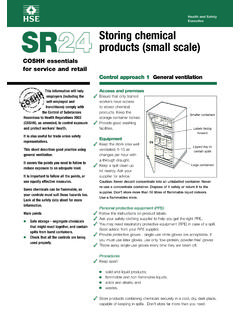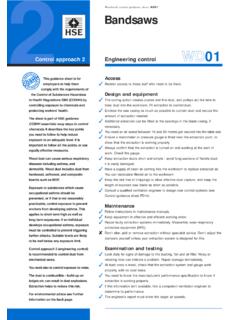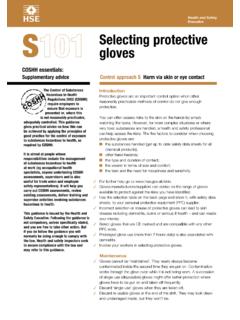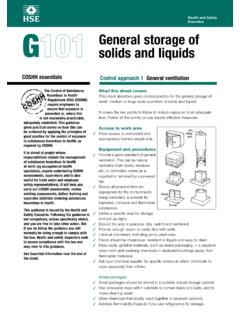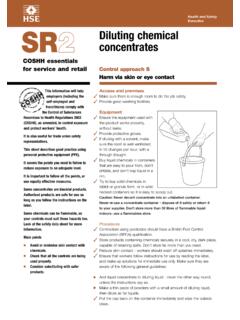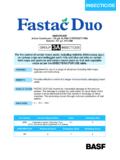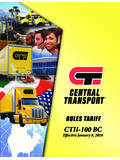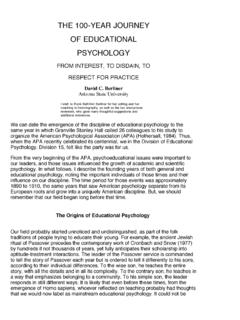Transcription of Health and Safety Executive G General ventilation
1 Health and Safety Executive G General ventilation COSHH essentials Control approach 1 General ventilation The Control of Substances What this sheet covers Hazardous to Health This sheet describes good control practice for General ventilation . Regulations 2002 (COSHH). require employers to It covers the key points you need to follow to reduce exposure to an ensure that exposure is prevented or, where this adequate level. Follow all the points, or use equally effective measures. is not reasonably practicable, adequately controlled. This guidance gives practical advice on how this can be achieved by applying the principles of good practice for the control of exposure Air out to substances hazardous to Health , as required by COSHH.
2 It is aimed at people whose Air in responsibilities include the management of substances hazardous to Health Controlled ventilation from a fan Natural ventilation at work (eg occupational Health specialists, anyone undertaking COSHH Access to work area assessments, supervisors and is also 3 Allow access to authorised and appropriately trained people only. useful for trade union and employee Safety representatives). It will help you Equipment and procedures carry out COSHH assessments, review existing assessments, deliver training and 3 Provide a good standard of General ventilation . This can be natural supervise activities involving substances ventilation from doors, windows etc, or controlled, where air is supplied hazardous to Health .
3 Or removed by a powered fan. 3 Ensure all powered fans are appropriate for the contaminants being This guidance is issued by the Health and Safety Executive . Following the guidance is controlled, ie suitable for explosive, corrosive and flammable substances. not compulsory, unless specifically stated, 3 If you work in a shop or office, natural ventilation will normally be and you are free to take other action. But enough to control dusts and vapours from cleaning materials etc. if you do follow the guidance you will 3 If you work in a factory, you will normally need controlled General normally be doing enough to comply with ventilation to remove contaminated air and make it up with clean the law. Health and Safety inspectors seek replacement air.
4 This can be a wall-mounted fan to extract or supply to secure compliance with the law and may refer to this guidance. air, with venting through airbricks, grills or louvres, or a more complex ducted air supply and removal system. See Essential information near the end of 3 Ensure that supplied or make up air comes from an uncontaminated area. the sheet. 3 Ensure that enough clean air is supplied to dilute and remove the dust or vapour produced. The rate of ventilation for an area is normally expressed in air changes per hour', ie the number of times per hour that the entire air volume of the area is changed. The rate selected depends of the type of room and the activity being undertaken. Typical applications range between 5 and 15 air changes per hour.
5 3 Discharge extracted air to a safe place away from doors, windows and air inlets. 3 With dusts, you can re-circulate clean, filtered air into the workroom. G100 General ventilation 3 With vapours, re-circulation is not recommended. 3 Ensure, where possible, that air comes from a clean source, flows past the worker and then past the work activity to the extraction point. Respiratory protective equipment (RPE). 3 RPE is not normally needed. 3 RPE may be needed for maintenance and cleaning. Personal protective equipment (PPE). 3 Chemicals identified by COSHH Essentials as hazard group S can damage the skin and eyes, or enter the body through the skin and cause harm. Check the Safety data sheets to see what PPE is needed.
6 3 Ask your supplier to advise on suitable protective equipment. 3 Make suitable arrangements for maintenance, storage and replacement of PPE. Personal decontamination 3 Provide warm water, mild skin cleansers, and soft paper or fabric towels for drying. Avoid abrasive cleansers. 3 Provide pre-work skin creams, which will make it easier to wash dirt from the skin. 3 Provide after-work creams to replace skin oils. Caution: Barrier creams' are not liquid gloves' and they do not provide a full barrier. Maintenance, examination and testing 3 Keep all equipment used for the task in effective working order. Maintain it as advised by the supplier or installer. 3 Check for signs of damage to control equipment before starting work.
7 3 Visually check all equipment at least once a week for signs of damage or faults. 3 Have equipment thoroughly examined and tested against its performance standard, at suitable intervals. 3 Keep records of all examinations for at least 5 years. 3 Don't forget you may need PPE for some maintenance tasks. Cleaning and housekeeping 3 Clean equipment and the work area daily. Clean other equipment and the workroom regularly at least once a week. 3 Vacuum dry dust or use wet cleaning methods. 3 Deal with spills immediately use suitable protective gloves. You may also need RPE. 3 Store containers in a safe place and dispose of empty containers safely. 3 Put lids on containers immediately after use. Caution: Never allow the use of brushes or compressed air for removing dust from skin and clothing.
8 Avoid the use of brushes or compressed air for removing dust from surfaces or from inside machinery. G100 General ventilation Training and supervision Employee checklist 3 Provide supervision ensure that safe work procedures are followed. 3 Tell workers about the hazards associated with their work. Check the room is well 0 3 Provide workers with training on: ventilated, and any n working safely with hazardous substances; extraction or air supply is n when and how to use controls; switched on and working n how to check they are working; and properly. n what to do if something goes wrong. Look for signs of leaks, 0 3 Consider keeping training records. wear and damage before 3 Involve managers and supervisors in Health and Safety training.
9 Every job. If you find any problems, 0 Essential information tell your supervisor. Don't General advice on chemicals causing harm via skin or eye contact COSHH just carry on working. Guidance Sheet S100 HSE Books 2015 Wash your hands before 0 starting the job, and before eating, drinking, smoking Selection of personal protective equipment COSHH Guidance Sheet S101 or using the lavatory. HSE Books 2015 Don't use solvents to clean 0 your skin. Further information Clear up spills immediately. 0 Safety data sheets For liquids, contain or absorb spills with granules You can find the full COSHH essentials series at or mats. For solids, use vacuum or wet cleaning. Dispose of spills safely. 0 Occupational Safety and Health Consultants Register Use, maintain and store 0 your PPE in accordance For information about Health and Safety , or to report inconsistencies or with instructions.
10 Inaccuracies in this guidance, visit You can view HSE. guidance online and order priced publications from the website. HSE priced publications are also available from bookshops. Crown copyright If you wish to reuse this information visit for details. First published 10/03. Published by the Health and Safety Executive 01/18. This document is available at.
